Oscilllator
National Hazard
   
Posts: 659
Registered: 8-10-2012
Location: The aqueous layer
Member Is Offline
Mood: No Mood
|
|
Molybdenum from molybdic acid - success!
2 weeks ago I obtained ~1kg of Molybdic acid (H2O.MoO3), 500g of sodium molybdate, and ~200g ammonium molybdate.
For lack of anything else to do, I decided to try and extract molybdenum metal from at least one of these compounds. This proved to be quite
difficult, partly because I didn't really know what I was doing. I tried reducing it from and aqueous solutions using aluminium powder and a bunch of
other stuff but it soon became apparent that my best bet was some kind of thermite.
This patent described using calcium molybdate in an aluminothermic reaction, and they claimed 90+% yield. However they used preheated 500g
charges in a special reaction chamber so unsurprisingly my ~60g attempt failed dismally.
I had the idea of using straight molybdic acid. This did work, but the reaction was quite sluggish and not all of the reaction mixture ignited. I then
decided to dehydrate the molybdic acd to molybdenum trioxide, however I couldn't find any data on Molybdic acids dehydration temperature. Like a true
mad scientist, I proceeded anyway. I filled up a crucible with the stuff and put it in my forge, which should be able to heat it to at least 1000
degrees. This melted the Molybdic acid with no trouble, however it turns out molybdenum trioxide is quite volatile at 1000 degrees, so a significant
quantity of black smoke was produced. A lid partially remedied this problem, and some interesting crystals formed in the crucible lid. It is
interesting that these crystals are clear, whereas the ones in the bottom are black. Any ideas as to why this is?
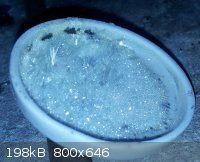
When cooled down Molybdenum trioxide (or at least thats what I think it is) is a black, crystalline solid that is reasonably easy to crush up in a
mortar and pestle. This is contrary to wikipedias page, which says its yellow or light blue. I did notice a distinct yellow colour while the molybdic acid was melting, but this was only transient.
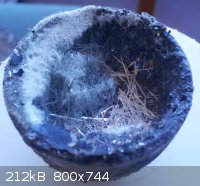 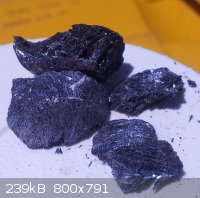
My total yield of MoO3 was 65.45g, and I mixed this with an excess (30g) of Al, and placed it in a cobbled-together brick enclosure. The reaction was
extremely vigorous, and the reaction was over in about a second, producing quite a lot of smoke.
Picture of the partially disassembled reaction chamber, and picture of a strange blue deposit:
 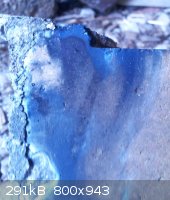
The total yield of Molybdenum metal was 30.2g, of which 18.3g was in the biggest chunk, seen glowing red in the above picture. This is a yield of 69%,
a surprisingly
high figure for a thermite reaction. A small amount was lost when some of the molybdenum chunks shattered, sending shards of molybdenum metal flying.
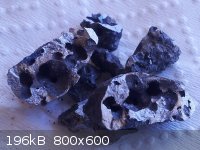
|
|
|
Zephyr
Hazard to Others
  
Posts: 341
Registered: 30-8-2013
Location: Seattle, WA
Member Is Offline
|
|
Good job, just a few questions;
Did you include the white crystals from the roof of the crucible in the thermite?
Where did you purchase your molybdates?
How much molybdic acid was placed in the crucible, and how much did the white crystals weigh?
And what do you plan to do with the molybdenum metal?
Thank you
|
|
|
Oscilllator
National Hazard
   
Posts: 659
Registered: 8-10-2012
Location: The aqueous layer
Member Is Offline
Mood: No Mood
|
|
1: Yes, I did include the white crystals
2: I didn't purchase them, I... inherited them  . If someone wants to buy a small
amount I may consider an offer or trade, but I'm not really looking to get rid of it. I also have some potassium iodide. . If someone wants to buy a small
amount I may consider an offer or trade, but I'm not really looking to get rid of it. I also have some potassium iodide.
3: I dont know how much molybdic acid was placed in the crucible, I just kept spooning it in as the melt occupied significantly less volume than the
dry powder. I dont know how much the white crystals weighed, but it was likely less than a gram.
4: I plan to put the molybdenum metal in my collection of cool stuff. Perhaps I shall do something else with it, it somebody suggests something
interesting that I can do.
|
|
|
UnintentionalChaos
International Hazard
    
Posts: 1454
Registered: 9-12-2006
Location: Mars
Member Is Offline
Mood: Nucleophilic
|
|
Molybdenum readily forms heteropolyacids with things like silicon oxides, arsenic oxides, phosphates, etc. which are typically strongly colored.
reduced or partly reduced molybdenum oxides are quite strongly colored. I expect there may have been some decomposition with loss of O2 to lower
oxides. The blue is probably the same materials, possibly modified further by the brick composition.
Very nice experiment. I don't think I've ever even heard of a molybdenum thermite and it looks like it worked very nicely. Even more impressive is
that molybdenum melts at 2623 °C. You are very lucky that the reaction was powerfully exothermic enough to melt it and didn't just explode like a
MnO2 thermite. Things like chromium (III) oxide and titanium thermites require additives to raise the reaction temperature and sometimes fluidize the
slag in order to get any metal to coalesce and both melt well below molybdenum.
As for other uses, ammonium molybdate catalyzes the formation of copper phthalocyanine from urea, phthalic anhydride, and anhydrous CuCl2. You could
try out some of woelen's experiments here: http://woelen.homescience.net/science/chem/exps/colorfulmoly... You can test for things like phosphate and arsenic in solution using molybdates
(formation of strongly colored heteropoly acids). I believe the arsenic test reduces the sample with vitamin C to convert arsenate to arsenite ion and
then treats it with an ammonium molybdate- sulfuric acid solution which forms a bright blue color. Phosphate tests yellow, I believe and does not need
reduction, but I would double check on those procedures.
Depending on where you live, I may be interested in trading for a small amount of molybdic acid. I have about 10g of ammonium heptamolybdate
tetrahydrate but it's not enough to try something like this with.
[Edited on 1-18-14 by UnintentionalChaos]
Department of Redundancy Department - Now with paperwork!
'In organic synthesis, we call decomposition products "crap", however this is not a IUPAC approved nomenclature.' -Nicodem
|
|
|
blogfast25
International Hazard
    
Posts: 10562
Registered: 3-2-2008
Location: Neverland
Member Is Offline
Mood: No Mood
|
|
Quote: Originally posted by UnintentionalChaos  |
Very nice experiment. I don't think I've ever even heard of a molybdenum thermite and it looks like it worked very nicely. Even more impressive is
that molybdenum melts at 2623 °C. You are very lucky that the reaction was powerfully exothermic enough to melt it and didn't just explode like a
MnO2 thermite. Things like chromium (III) oxide and titanium thermites require additives to raise the reaction temperature and sometimes fluidize the
slag in order to get any metal to coalesce and both melt well below molybdenum.
|
I’m the resident thermite nut and have known for a while that an MoO3 thermite should be possible. I happen not to have any MoO3 and don’t really
want to sacrifice the expensive NH4 molybdate I do have.
Luck doesn’t really come into it: the adiabatic temperature of MoO3 + 2 Al == > Mo + Al2O3 can be calculated and appears to be just right: above
the MP of Mo and below the BP of alumina. That MoO3 is a high oxide helps a lot: a dioxide probably wouldn’t generate enough reaction heat.
MnO2 thermites can be semi-explosive because of the low BP of Mn, which literally causes some of the metal to vapourise.
This reaction could be further improved upon by:
1. Not using an excess Al: all that does is cause the excess to end up in the target metal (but I don’t know whether Mo and Al alloy well). Instead
use a small excess of the oxide, this way all Al is consumed.
2. Use a slag fluidiser like CaF2 or CaO (about 10 % of total formulation): by reducing the viscosity of the melt, the metal/slag separation is
improved and the metal will collect better at the bottom of the crucible, with less voids and such like.
The yield of nearly 70 % is quite good for a first shot but could be higher by further optimising the formulation.
[Edited on 18-1-2014 by blogfast25]
|
|
|
blogfast25
International Hazard
    
Posts: 10562
Registered: 3-2-2008
Location: Neverland
Member Is Offline
Mood: No Mood
|
|
Quote: Originally posted by Oscilllator  | The total yield of Molybdenum metal was 30.2g, of which 18.3g was in the biggest chunk, seen glowing red in the above picture. This is a yield of 69%,
a surprisingly
high figure for a thermite reaction.
|
No, that is not a 'surprisingly high number'. In fact it's fairly mediocre. Yields of up to 90 % can be
obtained with well formulated thermites, preferably large ones.
Still: a very nice experiment, congrats!
|
|
|
Oscilllator
National Hazard
   
Posts: 659
Registered: 8-10-2012
Location: The aqueous layer
Member Is Offline
Mood: No Mood
|
|
Quote: Originally posted by blogfast25  |
2. Use a slag fluidiser like CaF2 or CaO (about 10 % of total formulation): by reducing the viscosity of the melt, the metal/slag separation is
improved and the metal will collect better at the bottom of the crucible, with less voids and such like.
The yield of nearly 70 % is quite good for a first shot but could be higher by further optimising the formulation.
[Edited on 18-1-2014 by blogfast25] |
The patent I linked used calcium molybdate because it lowered the melting point of the mixture. They also described using an excess of aluminium to
increase yield. They did not post the difference between no stoichiometric excess and 20% stoichiometric excess, however if you look at the article
you will see that an increase from 15% excess to 20% excess results in an increase in yield from 93.2% to 98.5%.
|
|
|
blogfast25
International Hazard
    
Posts: 10562
Registered: 3-2-2008
Location: Neverland
Member Is Offline
Mood: No Mood
|
|
I take yield determinations with a pinch of salt, in the case of thermite metal. And the problem remains: where does the excess Al go? There's a 55/45
Mo/Al alloy, so I think I know the answer to that question!
http://www.americanelements.com/moala.html
Using calcium molybdate is equivalent to using CaO: the molybdate is also reduced to Mo, leaving behind CaO. That forms low melting calcium aluminates
with the alumina, thus lowering slag viscosity. Or so the theory tells me...
[Edited on 19-1-2014 by blogfast25]
|
|
|
Oscilllator
National Hazard
   
Posts: 659
Registered: 8-10-2012
Location: The aqueous layer
Member Is Offline
Mood: No Mood
|
|
Today I crushed a small amount of the metal, placed it in the bottom of a test tube and then added concentrated sodium hydroxide solution. This did
not result in any bubbling, as one would expect if aluminium was present in the alloy. Are there any other convenient tests I could use to determine
if there was significant amounts of aluminium present in the molybdenum?
|
|
|
blogfast25
International Hazard
    
Posts: 10562
Registered: 3-2-2008
Location: Neverland
Member Is Offline
Mood: No Mood
|
|
According to this thread Mo dissolves in concentrated nitric acid:
http://www.sciencemadness.org/talk/viewthread.php?tid=10582
Then you can you and look for Al in the solution.
|
|
|
MrHomeScientist
International Hazard
    
Posts: 1806
Registered: 24-10-2010
Location: Flerovium
Member Is Offline
Mood: No Mood
|
|
Oscilllator:
Damn! I had just received some ammonium molybdate the other day for a different experiment, and had planned to use the excess to try a molybdenum
thermite. You beat me to it, though 
Nice work! How did you create your molybdic acid? The various wiki pages don't outright say this, but I infer that dissolving a molybdate salt in
water and adding acid precipitates MoO3(H2O)2. This is then heated to dehydrate, which is what you showed above. Wiki
does claim that both the dihydrate and monohydrate are bright yellow, though, which looks contrary to your experience.
My tentative plan would be:
1) Dissolve ammonium molybdate in distilled water.
2) Acidify with HCl to precipitate MoO3(H2O)2 and leave NH4Cl in solution.
3) Filter the oxide, dry, and heat in a crucible to dehydrate as much as possible.
4) Crush the products into a fine powder, mix with a stoichiometric amount of Al powder (and maybe a dash of CaF2 as blogfast suggested),
and ignite thermite-style.
[Edited on 1-21-2014 by MrHomeScientist]
|
|
|
blogfast25
International Hazard
    
Posts: 10562
Registered: 3-2-2008
Location: Neverland
Member Is Offline
Mood: No Mood
|
|
Quote: Originally posted by MrHomeScientist  | | 4) Crush the products into a fine powder, mix with a stoichiometric amount of Al powder (and maybe a dash of CaF as blogfast suggested), and ignite
thermite-style. |
It would be worth trying CaO instead of CaF<sub>2</sub>. A test with an MnO2 thermite recently showed that CaO works, although it wasn't a
neat back-to-back comparison with fluorite.
Lime is easier to get than fluorite and cheaper. It certainly is used on an industrial scale to fluidise alumina, because of that series of low
melting calcium aluminates:
http://en.wikipedia.org/wiki/Calcium_aluminates
|
|
|
MrHomeScientist
International Hazard
    
Posts: 1806
Registered: 24-10-2010
Location: Flerovium
Member Is Offline
Mood: No Mood
|
|
Besides being easier to find and cheaper, is there any other reason to use CaO over CaF2? (better separation, etc.) If it forms low-melting
calcium aluminates, then perhaps it would be preferred in reactions that don't produce a lot of heat on their own. I ask because I already have
fluorite powder but would have to make my own quicklime. Not out of the question, but it's an extra step I'd need to take. How's the rest of my scheme
sound?
|
|
|
blogfast25
International Hazard
    
Posts: 10562
Registered: 3-2-2008
Location: Neverland
Member Is Offline
Mood: No Mood
|
|
Mr HS:
Unfortunately, I've yet to make a straight back-to-back comparison, so I can't tell yet.
Reactions that don't produce a lot of heat just don't work, period. The adiabatic end temperature (AET) of the reaction must always be (considerably)
higher than the highest MP of the post reaction mix (MP of metal or MP of alumina, whichever is the highest), unless you can pre-heat of course.
Adding a slag fluidiser actually decreases the AET a little but from my experience much is usually gained in terms of metal/slag separation because
the slag/metal mixture is far more fluid. Reducing the slag's melting point also means the slag stays fluid longer, allowing more metal to settle out.
Quicklime here is available from eBay, cheap as chips.
Your plan sounds just fine to me.
|
|
|
Oscilllator
National Hazard
   
Posts: 659
Registered: 8-10-2012
Location: The aqueous layer
Member Is Offline
Mood: No Mood
|
|
Quote: Originally posted by MrHomeScientist  | Oscilllator:
Damn! I had just received some ammonium molybdate the other day for a different experiment, and had planned to use the excess to try a molybdenum
thermite. You beat me to it, though 
Nice work! How did you create your molybdic acid? The various wiki pages don't outright say this, but I infer that dissolving a molybdate salt in
water and adding acid precipitates MoO3(H2O)2. This is then heated to dehydrate, which is what you showed above. Wiki
does claim that both the dihydrate and monohydrate are bright yellow, though, which looks contrary to your experience.
My tentative plan would be:
1) Dissolve ammonium molybdate in distilled water.
2) Acidify with HCl to precipitate MoO3(H2O)2 and leave NH4Cl in solution.
3) Filter the oxide, dry, and heat in a crucible to dehydrate as much as possible.
4) Crush the products into a fine powder, mix with a stoichiometric amount of Al powder (and maybe a dash of CaF2 as blogfast suggested),
and ignite thermite-style.
[Edited on 1-21-2014 by MrHomeScientist] |
I didn't have to make my molybdic acid, as it came as-is in a jar. However I did notice a white precipitate upon the addition of HCl to a concentrated
solution of sodium molybdate, so your proposed method sounds like it should work fine. Be sure to use concentrated cold solutions, as I'm pretty sure
molybdic acid has a significant solubility in water. Wikipedia says its "1510 mg dm-3" but I have no idea what that means.
Despite what blogfast25 says, I think it would be a good idea to use a stoichometric excess of aluminium powder, as the patent did say it resulted in
higher yields. I have yet to do a proper test for aluminium in the molybdenum metal however, so its up to you.
|
|
|
blogfast25
International Hazard
    
Posts: 10562
Registered: 3-2-2008
Location: Neverland
Member Is Offline
Mood: No Mood
|
|
Quote: Originally posted by Oscilllator  | | Despite what blogfast25 says, I think it would be a good idea to use a stoichometric excess of aluminium powder, as the patent did say it resulted in
higher yields. I have yet to do a proper test for aluminium in the molybdenum metal however, so its up to you. |
What's the point in having a (reported) higher yield of contaminated metal? You seem to desperately cling to the idea that the excess Al will have
somehow vanished into thin air. But that doesn't happen.
You're creating an alloy. Wilfully or not.
[Edited on 22-1-2014 by blogfast25]
|
|
|
blogfast25
International Hazard
    
Posts: 10562
Registered: 3-2-2008
Location: Neverland
Member Is Offline
Mood: No Mood
|
|
Also, what you claim to be a patent appears to be a scientific paper. C.K.Gupta is certainly one of the most prolific writers on the subject of
metallothermy.
"This investigation deals with a process for extracting molybdenum metal in well consoli-dated form and in good yield from calcium molybdate, by
open aluminothermic reduction. Aluminothermic molybdenum has been further processed both by electron-beam melting and by molten salt electrorefining
for the removal of aluminium {my emph.}."
This very different from what you did. Using calcium molybdate as the starting material requires pre-heating because the reaction produces much more
slag and this absorbs more heat, leading to lower adiabatic end temperature.
Note also how excess aluminium in the Mo is removed by refining.
[Edited on 22-1-2014 by blogfast25]
|
|
|
samarium14
National Hazard
   
Posts: 661
Registered: 22-3-2019
Location: Georgia
Member Is Offline
|
|
Can I use sodium fluoride instead of calcium fluoride or sodium hexafluoroaluminate?
|
|
|
bluamine
Hazard to Others
  
Posts: 197
Registered: 17-8-2015
Member Is Offline
Mood: No Mood
|
|
Well done!
|
|
|